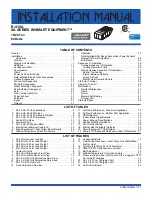
27
INSTALLATION OF HORIZONTAL THROUGH THE
WALL VENT SYSTEM
If you are installing your system so that it vents through roof, please
refer to section titled VERTICAL VENT TERMINAL INSTALLATION.
VENT TERMINAL INSTALLATION, SIDEWALL
1. Install the vent terminal by using the cover plate as a template to
mark the hole for the vent pipe to pass through the wall. BEWARE
OF CONCEALED WIRING AND PIPING INSIDE THE WALL.
2. If the Vent Terminal is being installed on the outside of a finished
wall, it may be easier to mark both the inside and outside wall.
Align the holes by drilling a hole through the center of the
template from the inside through to the outside. The template
can now be positioned on the outside wall using the drilled hole
as a centering point for the template.
3. A) MASONRY SIDE WALLS
Chisel an opening approximately one half inch (1.3 cm) larger
than the marked circle.
B) WOODEN SIDE WALLS
Drill a pilot hole approximately one quarter inch (0.64 cm) outside
of the marked circle. This pilot hole is used as a starting point
for a saws-all or sabre saw blade. Cut around the marked circle
staying approximately one quarter inch (0.64 cm) outside of the
line. (This will allow the vent to easily slide through the opening.
The resulting gap will be covered up by the Vent Terminal cover
plate.) Repeat this step on inside wall if necessary.
Cut a length of pipe about 3.5 inches (8.9 cm) longer than the wall
thickness at the opening. Glue the vent terminal to this section of pipe.
Slide the wall plate over the pipe to stop against the vent terminal.
Place a bead of caulking (not supplied) around the gap between the
pipe and cover plate. Apply enough to fill some of the gap between
the pipe and wall. Place some of the caulking on the back of the plate
to hold it against the wall after installation. If the vent pipe is installed
up to the wall, with a coupling on the end against the wall opening,
the pipe with the vent terminal can be prepared for gluing before
inserting through the wall. Slide the pipe through the wall and insert
into the coupling on the other side of the wall, making sure that the
vent terminal ends up pointed in the correct position, see Figure 13.
Figure 13: VENT TERMINATION
VENT PIPE TERMINATION
The first step is to determine where the vent pipe will terminate. See
Figures 13, “Figure: 14A”, and “Figure: 15”. The vent may terminate
through a sidewall as shown in Figure 13 and “Figure: 15” or through
the roof as shown in “Figure: 16” and “Figure: 17”.
The vent system must terminate so that proper clearances are
maintained as cited in local codes or the current edition of the
National Fuel Gas Code, (ANSI Z223.1, 12.9.1 through 12.9.4) or
the Natural Gas and Propane Installation Code (CAN/CSA-B149.1).
See “Figure: 16” and “Figure: 17”.
Instructions on proper installation through a sidewall are provided
in Figures 13, “Figure: 14A”, and “Figure: 15”.
Plan the vent system layout so that proper clearances are
maintained from plumbing and wiring.
Vent pipes serving power vented water heaters are classified by
building codes as vent connectors. Required clearances from
combustible materials must be provided in accordance with
information in this manual under FACTS TO CONSIDER ABOUT
LOCATION
and INSTALLING THE WATER HEATER, and with the
National Fuel Gas Code and local codes.
PLANNING THE VENT SYSTEM
Plan the route of the vent system from the exhaust elbow to the
planned location of the vent terminal.
1. Layout total vent system to use a minimum of vent pipe and
elbows.
2. This water heater is capable of venting flue gases in equivalent
feet of pipe as listed in Table 7.
Table 7
Number of
90° Elbows
2” Maximum
Pipe - ft. (m)
3” Maximum
Pipe - ft. (m)
1
40 (12.19)
120 (36.57)
2
35 (10.66)
115 (35.05)
3
30 (9.14)
110 (33.52)
4
25 (7.62)
105 (32)
5
20 (6.09)
100 (30.48)
6
15 (4.57)
95 (28.95)
The minimum vent length for each of the pipe size is one 90° elbow
plus 2’ and 7’ (0.61 m and 2.1 m) of straight pipe for air intake and
exhaust vent respectively and the appropriate termination.
NOTE:
The equivalent feet (m) of pipe listed above are exclusive
of the termination. That is, the termination, with an installed
screen, is assumed to be in the system and the remainder of
the system must not exceed the lengths and number of elbows
shown in Table 7.
If using 2” inch vent pipe:
A 2” diameter vent pipe must be
inserted and glued to the exhaust elbow assembly.
If using 3” inch vent pipe:
Two inches (5.1cm) of 2” diameter pipe
must be inserted and glued to the exhaust elbow assembly before
adding a 2’ x 3” reducer to acquire the desired pipe diameter. A
3” coupling (supplied locally-a schedule 40 DWV) vent terminal
must be obtained. A 3” diameter screen is supplied in the vent
kit.
Содержание BTX 100
Страница 5: ...5 GENERAL SAFETY INFORMATION ...
Страница 37: ...37 LIGHTING AND OPERATION LABELS ...
















































